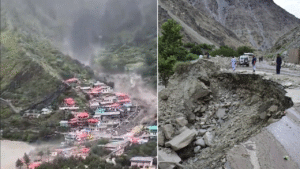The devastating Dharali flash flood has shocked environmental scientists and local communities across northern India recently. Experts estimate that approximately 360 million cubic metres of glacial debris crashed down mountainsides with tremendous force. This catastrophic event highlights growing concerns about climate change impacts on Himalayan glacier stability.
Understanding the Scale of This Natural Catastrophe
The sheer volume of debris that came tumbling down defies comprehension for most people witnessing the aftermath. Picture approximately 144,000 Olympic-sized swimming pools worth of rocks, ice, and sediment racing downhill simultaneously. This massive material flow created destruction paths extending several kilometres through mountain valleys below.
Scientific teams working in the affected areas describe scenes of unprecedented devastation and geological chaos. Entire forest sections disappeared under thick layers of rocky debris and glacial materials. River channels completely changed course due to the enormous volume of displaced earth materials.
The event occurred when unstable glacier sections broke away from higher mountain slopes during recent warming periods. Temperature fluctuations weakened ice formations that had remained stable for centuries or longer periods. Climate scientists point to this incident as clear evidence of accelerating glacial retreat processes.
Breaking Down the Scientific Analysis and Findings
Geological surveys reveal that multiple glacier sections failed simultaneously, creating this catastrophic debris flow event. Experts estimate that the combined weight exceeded several billion tons of mixed materials flowing downward rapidly. Advanced satellite imagery helps scientists track the exact scope and impact zones affected.
Research teams identify three primary factors contributing to this massive glacial collapse and resulting flood:
- Rising average temperatures are weakening ice structural integrity significantly
- Increased rainfall is creating additional pressure on already unstable glacier bases
- Seismic activity potentially triggers final collapse events in weakened glacier sections
Geologists studying core samples from the debris field discover materials dating back thousands of years. Ancient rock formations mixed with recent ice deposits create complex geological puzzles requiring extensive analysis. Temperature records show trends that could indicate similar future events.
Environmental Impact Assessment and Long-term Consequences
The glacial debris has fundamentally altered local ecosystem balance and water flow patterns throughout the region. Aquatic habitats disappeared overnight when rivers changed course or became completely blocked by debris dams. Wildlife migration routes face permanent disruption due to dramatically changed terrain features.
Water quality concerns emerge as the debris contains various minerals and potentially harmful substances from ancient deposits. Local communities depend on these water sources for drinking, agriculture, and other essential daily activities. Testing procedures continue to monitor contamination levels and safety standards.
Vegetation recovery could take decades, given the massive scale of soil displacement and habitat destruction. Native plant species require specific soil conditions that no longer exist in many areas. Reforestation efforts must account for completely altered topography and drainage patterns.
Community Response and Emergency Management Efforts
Local authorities coordinated rapid evacuation procedures when early warning systems detected the approaching debris flow. Emergency response teams worked around the clock to ensure resident safety and provide essential services. Communication networks suffered significant damage, complicating coordination efforts during critical initial hours.
Relief organisations mobilised quickly to provide temporary housing, clean water, and medical assistance for displaced families. International aid agencies offered technical expertise and financial support for long-term recovery planning initiatives. Government officials pledge comprehensive rehabilitation programs for affected communities.
Traditional knowledge from local elders proves invaluable in understanding historical precedents and potential future risks. Community members share stories about smaller, similar events from previous generations that provide important context. This local wisdom combines with modern scientific analysis to improve future preparedness strategies.
Climate Change Implications and Future Risk Assessment
The Dharali flash flood serves as a stark reminder of climate change impacts on mountain environments worldwide. Rising global temperatures accelerate glacier melting rates and increase instability in previously stable formations. Scientists predict more frequent similar events as warming trends continue across the Himalayan regions.
International climate researchers study this event to better understand glacier lake outburst flood mechanisms and triggers. Data collected here informs global models predicting similar risks in other mountainous regions worldwide. Early warning systems require improvements based on lessons learned from this catastrophe.
Mountain communities across Asia face increasing vulnerability to glacier-related hazards as climate patterns shift dramatically. Adaptation strategies must account for these new realities while protecting traditional ways of life. Investment in monitoring technology and emergency preparedness becomes increasingly critical for vulnerable populations.
Moving Forward: Prevention Strategies
Recovery efforts focus on building back better with improved resilience against future glacial hazards and extreme weather. Engineering solutions include early warning systems, protective barriers, and improved drainage infrastructure throughout vulnerable valleys. Community education programs help residents recognise warning signs and respond appropriately.
Scientific monitoring stations will provide continuous data about glacier stability and environmental conditions in nearby areas. This information enables better prediction capabilities and more effective emergency response planning for future events. International cooperation enhances knowledge sharing and technical assistance programs.
The 360 million cubic metres of debris will remain a permanent reminder of nature’s awesome power. Recovery processes offer opportunities to rebuild communities with greater sustainability and climate resilience built into every aspect.








Be First to Comment